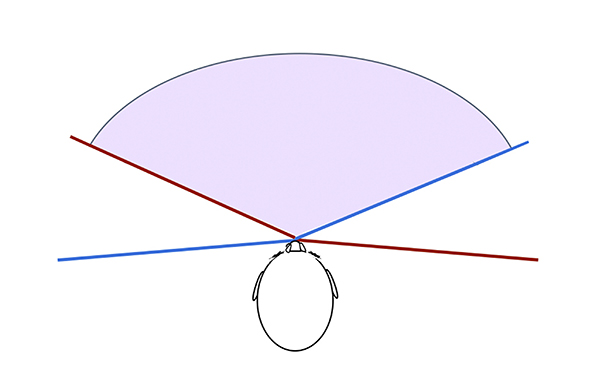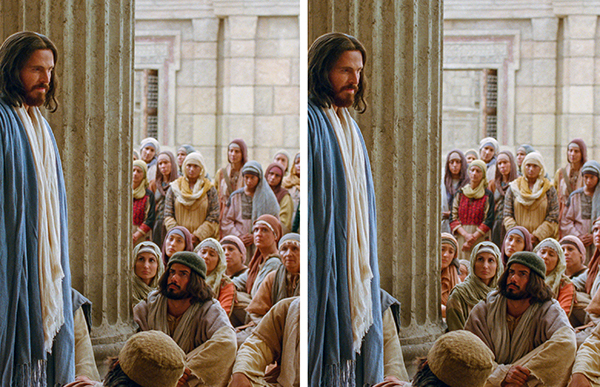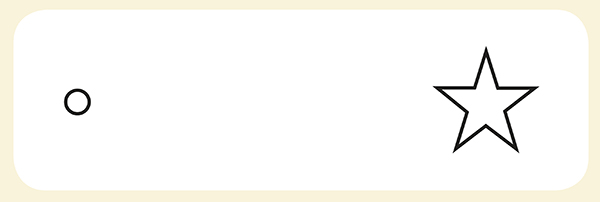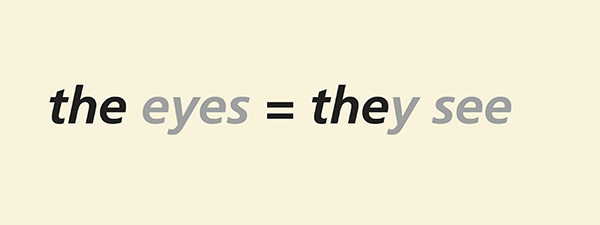
3 Nephi 11-13
Elder Lynn G. Robbins:
Multiple scientific analyses illustrate the advantages of two eyes over one. I will explore six of those advantages and their spiritual parallels with the Book of Mormon as a second eyewitness of Jesus Christ in restoring spiritual eyesight to the world.
1. Two Eyes Increase the Field of Vision and Enhance Clarity
Humans have a maximum horizontal field of view of around 190 degrees with two eyes, approximately 120 degrees of which overlaps or is seen by both eyes. Beyond the converging field of view, each eye also has a peripheral field unique to that eye.
After centuries of plain and precious things being lost, the Bible enjoyed something less than perfect eyesight. The coming forth of the Book of Mormon with its perfect eyesight not only increased the field of spiritual vision but also gave much-needed clarity to the overlapping portion of the two spiritual eyes, or the binocular field of vision—scripturally we call this the law of two witnesses (see Matthew 18:16; Ether 5:4; D&C 6:28).
The overlapping field of vision, or binocular summation, enhances the ability to detect faint objects.3 We see things more clearly as the separate views received in each eye are combined into a single image, giving us a convergence of the visual axis and thus eliminating the “confusion and strife” that so bewildered young Joseph (see Joseph Smith—History 1:8).
The fact that two eyes are better than one is such a universal and self-evident fact that Isaiah couldn’t have chosen a better metaphor for worldwide identification: “the eyes of the blind shall see” (Isaiah 29:18). We hope that those who currently see with just one spiritual eye, the Bible, will recognize the wisdom of not rejecting the Book of Mormon as a second eyewitness of Jesus Christ before they even give it a try. They will discover that “the stick of Judah” and the “stick of Joseph” (Ezekiel 37:19) converge as two eyes synced in perfect and clear unison—an eye-opening experience!
2. Stereopsis—Avoiding Deception
“Binocular vision … allows humans to walk over and around obstacles at greater speed and with more assurance” because of more precise depth perception. An example of this superior depth perception is demonstrated in the 3-D clarity of a stereoscope image over a simple photograph.
In the animal kingdom, two eyes give potential prey stereopsis, or precise depth perception, and the ability to discern 3-D disparities, thus helping it “to break the camouflage of [a potential predator].”
The Book of Mormon provides the world with similar protection by restoring clarity and divine depth perception to the spiritual binocular field, allowing us to avoid Satan’s camouflage and deceptions. He cleverly introduced confusion by blurring the meaning of many biblical passages. The Book of Mormon broke his camouflage with crystal-clear corroboration, “unto the confounding of false doctrines” (2 Nephi 3:12) and the “divid[ing] asunder all the cunning and the snares and the wiles of the devil” (Helaman 3:29).
President Ezra Taft Benson (1899–1994) shared this reassuring promise of the Book of Mormon: “There is a power in the book which will begin to flow into your lives the moment you begin a serious study of the book. You will find greater power to resist temptation. You will find the power to avoid deception. You will find the power to stay on the strait and narrow path.”
3. Seeing around Obstructions
Binocular vision helps a person to see more of, or all of, an object behind an obstruction. This advantage was pointed out by Leonardo da Vinci, who noted that a vertical column obscuring an object might block some or all of the object from the left eye but that the object might yet be visible to the right eye.
A spiritual example of this is found in the Savior’s words to the Judeans: “And other sheep I have, which are not of this fold: them also I must bring, and they shall hear my voice; and there shall be one fold, and one shepherd” (John 10:16).
Because Jesus did not identify those other sheep, the Jews could not decipher His statement. However, with the additional perspective from the Book of Mormon, that which was hidden became visible: “And verily I say unto you, that ye are they of whom I said: Other sheep I have which are not of this fold; them also I must bring, and they shall hear my voice; and there shall be one fold, and one shepherd” (3 Nephi 15:21). The result was a clear field of vision with no misunderstanding of what the Savior meant—no more obstacle illusions.
4. The Peripheral Advantages of Each Eye
“Peripheral vision is a part of vision that occurs outside the very center of gaze.” In other words, we are aware of things in the field of vision on which we aren’t actually focused. Part of that field of vision—that which is outside the range of the binocular field, or stereoscopic vision—is unique to each eye.
We are profoundly grateful for the Bible and what it uniquely and magnificently gives us—most important, the history of the life and ministry of Jesus Christ.
We are also deeply grateful for the Book of Mormon and the 20/20 untainted vision it provides for us, which clarifies the doctrine of Christ and reveals His teachings through the prophets of ancient America and His personal visitation and ministry to the Nephites.
Like two eyes divinely paired, the Bible and the Book of Mormon complement each other, resulting in a spectacular binocular panorama, as well as vistas unique to each.
5. Eliminating Our Blind Spot
We all have a blind spot in our field of vision that is relatively easy to identify. Hold the illustration of the circle and star straight in front of you at arm’s length. Close your left eye and focus your right eye directly on the small circle. With your right eye staring at the circle, slowly begin moving the image toward you. Somewhere around halfway, the star will disappear from the peripheral view.
Surprised? You didn’t know you have a blind spot? Just as your second eye compensates for this blind spot, the Book of Mormon provides a similar benefit to the Bible.
And just as the star vanished before your very eye, Herod had not seen the Bethlehem star and had to ask the Wise Men “what time the star appeared” (Matthew 2:7). It was in his spiritual peripheral blind spot. Only those looking for the star had noticed it.
Today there are many, like Herod, who refuse to look for and see the things of the Spirit. “Wo unto the blind that will not see” (2 Nephi 9:32). Pride also caused the Jews to “[despise] the words of plainness, and … blindness came [to them] by looking beyond the mark” (Jacob 4:14).
One of the sobering in-sights of the Book of Mormon is a forewarning about the universal blind spot of pride, “a sin that can readily be seen in others but is rarely admitted in ourselves.”10 It is like bad breath—obvious to everyone but the offender.
“In the premortal council, it was pride that felled Lucifer.”11 It was “the pride of … the Nephites, [that] hath proven their destruction” (Moroni 8:27). It is the proud who will burn as stubble when God cleanses the earth by fire (see Malachi 4:1; 3 Nephi 25:1).
The trailhead of the strait and narrow path is posted with a looming “warning” sign: “BEWARE of pride, lest ye become as the Nephites of old” (D&C 38:39; emphasis added). The tragic irony is that the “BEWARE” sign itself is usually in the blind spot of the proud. Therefore, “let him that is [proud] learn wisdom by humbling himself and calling upon the Lord his God, that his eyes may be opened that he may see” (D&C 136:32).
6. The Eye-Brain Connection
This clever anagram appears to be an accurate equation, but it isn’t entirely correct. It is actually the brain’s imaging system that tells us what our eyes are seeing. The brain creates our dreams by night and interprets what we see by day. Seeing isn’t necessarily believing or seeing correctly. For example: “But though [Jesus] had done so many miracles before them, yet they believed not on him” (John 12:37). The eyes alone are insufficient to foster belief or true seeing.
Just as the brain works in tandem with the eyes, the Spirit works in tandem with the scriptures, which help us see spiritually. Merely reading the scriptures isn’t enough to produce spiritual sight because “the natural man receiveth not the things of the Spirit of God: for they are foolishness unto him: neither can he know them, because they are spiritually discerned” (1 Corinthians 2:14).
For the Book of Mormon to function as a spiritual eye, we must accept and sincerely follow Moroni’s invitation in Moroni 10:3–5. It is an invitation with a promise that God “will manifest the truth of it unto you, by the power of the Holy Ghost” (verse 4; emphasis added).
Witness and Gratitude
To avoid spiritual blindness, Lehi’s sons risked their lives to obtain the brass plates (see 1 Nephi 3–4). Without the plates, they “would have dwindled in unbelief” (Mosiah 1:5). Today, thanks to the printing press and digital tools, we have easier and quicker access to the scriptures. It makes little difference to Satan, however, whether he keeps people from obtaining them—his strategy in the Dark Ages—or tempts people not to read them—his strategy in the latter days. Either way, his “mists of darkness [successfully] … blindeth the eyes … of the children of men … that they perish and are lost” (1 Nephi 12:17; emphasis added).
Like my daily eye drops, it is only by “continually holding fast to the rod of iron” (1 Nephi 8:30; emphasis added) that we can avoid being blinded by the latter-day mists that are so subtle and prevalent. Whenever a person becomes less active or leaves the Church, it’s almost a certainty that person has stopped reading the Book of Mormon.
The Book of Mormon: Another Testament of Jesus Christ is indeed a marvelous work and a wonder. It is a second eyewitness of Jesus Christ and His glorious gospel, offering all the advantages of a second eye.
May we continually hold fast to the iron rod that we too may be worthy of the Savior’s praise to His disciples: “Blessed are your eyes, for they see” (Matthew 13:16). (“The Eyes of the Blind Shall See,” Ensign, June 2016.)






